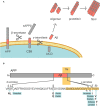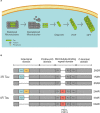Mouse Models of Alzheimer's Disease
- PMID: 35799899
- PMCID: PMC9254908
- DOI: 10.3389/fnmol.2022.912995
Mouse Models of Alzheimer's Disease
Abstract
Alzheimer's disease (AD) is a neurodegenerative disorder characterized by memory loss and personality changes, eventually leading to dementia. The pathological hallmarks of AD are senile plaques and neurofibrillary tangles, which comprise abnormally aggregated β-amyloid peptide (Aβ) and hyperphosphorylated tau protein. To develop preventive, diagnostic, and therapeutic strategies for AD, it is essential to establish animal models that recapitulate the pathophysiological process of AD. In this review, we will summarize the advantages and limitations of various mouse models of AD, including transgenic, knock-in, and injection models based on Aβ and tau. We will also discuss other mouse models based on neuroinflammation because recent genetic studies have suggested that microglia are crucial in the pathogenesis of AD. Although each mouse model has its advantages and disadvantages, further research on AD pathobiology will lead to the establishment of more accurate mouse models, and accelerate the development of innovative therapeutics.
Keywords: Alzheimer’s disease; mouse model; tau; therapeutics; β-amyloid.
Copyright © 2022 Yokoyama, Kobayashi, Tatsumi and Tomita.
Conflict of interest statement
The authors declare that the research was conducted in the absence of any commercial or financial relationships that could be construed as a potential conflict of interest.
Figures


Similar articles
-
Molecular and functional signatures in a novel Alzheimer's disease mouse model assessed by quantitative proteomics.Mol Neurodegener. 2018 Jan 16;13(1):2. doi: 10.1186/s13024-017-0234-4. Mol Neurodegener. 2018. PMID: 29338754 Free PMC article.
-
Fibrillar Aβ triggers microglial proteome alterations and dysfunction in Alzheimer mouse models.Elife. 2020 Jun 8;9:e54083. doi: 10.7554/eLife.54083. Elife. 2020. PMID: 32510331 Free PMC article.
-
Alzheimer's disease.Subcell Biochem. 2012;65:329-52. doi: 10.1007/978-94-007-5416-4_14. Subcell Biochem. 2012. PMID: 23225010 Review.
-
The usefulness and challenges of transgenic mouse models in the study of Alzheimer's disease.CNS Neurol Disord Drug Targets. 2010 Aug;9(4):386-94. doi: 10.2174/187152710791556168. CNS Neurol Disord Drug Targets. 2010. PMID: 20522016 Review.
-
Role of tau protein in Alzheimer's disease: The prime pathological player.Int J Biol Macromol. 2020 Nov 15;163:1599-1617. doi: 10.1016/j.ijbiomac.2020.07.327. Epub 2020 Aug 9. Int J Biol Macromol. 2020. PMID: 32784025 Review.
Cited by
-
Pharmacological inhibition of PLK2 kinase activity mitigates cognitive decline but aggravates APP pathology in a sex-dependent manner in APP/PS1 mouse model of Alzheimer's disease.Heliyon. 2024 Oct 18;10(20):e39571. doi: 10.1016/j.heliyon.2024.e39571. eCollection 2024 Oct 30. Heliyon. 2024. PMID: 39498012 Free PMC article.
-
Detecting Central Auditory Processing Disorders in Awake Mice.Brain Sci. 2023 Oct 31;13(11):1539. doi: 10.3390/brainsci13111539. Brain Sci. 2023. PMID: 38002499 Free PMC article.
-
ERRα and ERRγ coordinate expression of genes associated with Alzheimer's disease, inhibiting DKK1 to suppress tau phosphorylation.Proc Natl Acad Sci U S A. 2024 Sep 10;121(37):e2406854121. doi: 10.1073/pnas.2406854121. Epub 2024 Sep 4. Proc Natl Acad Sci U S A. 2024. PMID: 39231208
-
Multifactor Analyses of Frontal Cortex Lipids in the APP/PS1 Model of Familial Alzheimer's Disease Reveal Anomalies in Responses to Dietary n-3 PUFA and Estrogenic Treatments.Genes (Basel). 2024 Jun 19;15(6):810. doi: 10.3390/genes15060810. Genes (Basel). 2024. PMID: 38927745 Free PMC article.
-
Beta-sitosterol mitigates cognitive deficit and hippocampal neurodegeneration in mice with trimethyltin-induced toxicity.Exp Anim. 2024 Oct 23;73(4):433-445. doi: 10.1538/expanim.24-0021. Epub 2024 Jun 28. Exp Anim. 2024. PMID: 38945945 Free PMC article.
References
-
- Ahmed Z., Cooper J., Murray T. K., Garn K., McNaughton E., Clarke H., et al. . (2014). A novel in vivo model of tau propagation with rapid and progressive neurofibrillary tangle pathology: the pattern of spread is determined by connectivity, not proximity. Acta Neuropathol. 127, 667–683. 10.1007/s00401-014-1254-6 - DOI - PMC - PubMed
Publication types
LinkOut - more resources
Full Text Sources
Other Literature Sources

